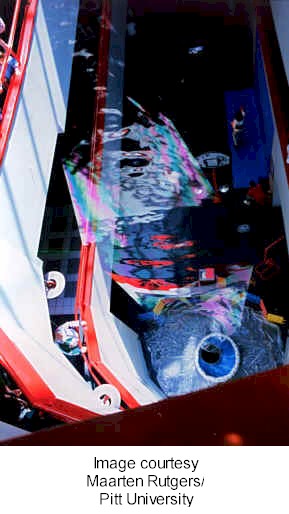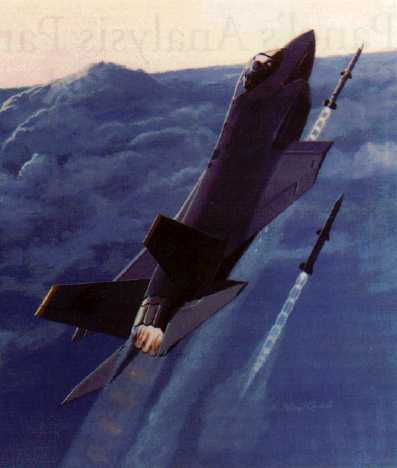A Road Map for the Teaching of
an Integrated Thermal & Fluids Course
![]()
Note: The links below provide "jumping off" points to relevant subjects relating to the teaching of the thermal and fluid sciences. Links with a blue button connect to pages directly relating to the teaching of the course. Green buttons denote links to outside sites usually concern practical applications and/or the state-of-the-art thermal related technology. For more information on the pictures below, click on them.
![]()
![]() Solar Power Plant/Heat Transfer - An overview of a complete thermal system through the presentation of a solar power plant operated by the SunLab
(a virtual lab operated by Sandia National Lab. and the National Renewable Energy
Lab.). Three modes of heat transfer, radiation, convection, and conduction, are
introduced here.
Solar Power Plant/Heat Transfer - An overview of a complete thermal system through the presentation of a solar power plant operated by the SunLab
(a virtual lab operated by Sandia National Lab. and the National Renewable Energy
Lab.). Three modes of heat transfer, radiation, convection, and conduction, are
introduced here.
![]() Fluid Mechanics - Physical science
dealing with the action of fluids at rest (fluid statics) or in motion (fluid dynamics),
and their interaction with flow devices and its applications in engineering. Case
study of the National Wind Technology Center (NWTC) develops innovative
wind turbine technology through the better understanding of the principles of fluid
mechanics.
Fluid Mechanics - Physical science
dealing with the action of fluids at rest (fluid statics) or in motion (fluid dynamics),
and their interaction with flow devices and its applications in engineering. Case
study of the National Wind Technology Center (NWTC) develops innovative
wind turbine technology through the better understanding of the principles of fluid
mechanics.
![]() Thermodynamics-Science
of Thermo (heat) and Dynamics (force or work). Physics that describes and correlates
the physical properties of macroscopic systems of matter and energy and their capabilities
to deliver work. It discusses thermodynamics
cycles and their analysis in practical applications. Thermal considerations of the design of a jet Engine from the Rolls
Royce Engine Inc. is used as a case study here.
Thermodynamics-Science
of Thermo (heat) and Dynamics (force or work). Physics that describes and correlates
the physical properties of macroscopic systems of matter and energy and their capabilities
to deliver work. It discusses thermodynamics
cycles and their analysis in practical applications. Thermal considerations of the design of a jet Engine from the Rolls
Royce Engine Inc. is used as a case study here. 
![]() Power Plant - A virtual tour-A
comprehensive web guide to all
issues concerning the design and the operation of a nuclear power plant. An
excellent supplement for the teaching of the steam Rankine power cycle.
Power Plant - A virtual tour-A
comprehensive web guide to all
issues concerning the design and the operation of a nuclear power plant. An
excellent supplement for the teaching of the steam Rankine power cycle.
![]() Power Plant image map-Links to an active image map of a nuclear power plant.
Click on different areas to enlarge specific components and procure information. Provide a global view of the complete layout of a power plant.
Power Plant image map-Links to an active image map of a nuclear power plant.
Click on different areas to enlarge specific components and procure information. Provide a global view of the complete layout of a power plant.
![]() Internal
Combustion Engine-Links to "How
Stuff Works", a very large site with information on how a multitude of objects work. Idea to pay a visit when introducing the gas power
systems like Otto and Diesel cycles.
Internal
Combustion Engine-Links to "How
Stuff Works", a very large site with information on how a multitude of objects work. Idea to pay a visit when introducing the gas power
systems like Otto and Diesel cycles.
![]() Automobile-Explains how an automobile works, separated into ten different
systems, including Engine, Drive Train, Exhaust, etc.
Automobile-Explains how an automobile works, separated into ten different
systems, including Engine, Drive Train, Exhaust, etc.
![]() Jet Engines-Operating principles of jet engines. An interesting
site to visit before the discussion of the aircraft propulsion and the Brayton
cycle.
Jet Engines-Operating principles of jet engines. An interesting
site to visit before the discussion of the aircraft propulsion and the Brayton
cycle.
![]()
The second class places more emphasis on the subjects of the heat transfer and the fluid mechanics. We will begin our discussion by introducing the extended-surface/fin analysis for heat transfer enhancement. As an example, we will investigate the heat dissipation analysis of a Pentium CPU chip.
![]() Enhanced Heat
Transfer-The use of extended-surface/fin analysis for heat transfer enhancement is
discussed. As an example,
we will investigate the heat dissipation analysis of a Pentium CPU chip and other cooling
concepts applied to electronic devices. Use the thermal resistance concept and its
application to the CPU heat sink as a practical case study.
Enhanced Heat
Transfer-The use of extended-surface/fin analysis for heat transfer enhancement is
discussed. As an example,
we will investigate the heat dissipation analysis of a Pentium CPU chip and other cooling
concepts applied to electronic devices. Use the thermal resistance concept and its
application to the CPU heat sink as a practical case study.
![]() Computational
Methods-Computational methods using finite difference and/or finite element schemes are frequently being used for thermal and fluids problems. Several applications using these computational
fluid dynamics (CFD) packages are presented. In addition, on-line resources in the
computational field will be provided.
Computational
Methods-Computational methods using finite difference and/or finite element schemes are frequently being used for thermal and fluids problems. Several applications using these computational
fluid dynamics (CFD) packages are presented. In addition, on-line resources in the
computational field will be provided.
![]() Thermal Spray-Many real-world thermal
problems requires the understanding of the transient time response of the heat transfer
process. One such example is the thermal spray process commonly used in material
coating industry. Applications of
unsteady heat transfer and the lumped capacitance
Thermal Spray-Many real-world thermal
problems requires the understanding of the transient time response of the heat transfer
process. One such example is the thermal spray process commonly used in material
coating industry. Applications of
unsteady heat transfer and the lumped capacitance![]() method are
discussed here.
method are
discussed here.
![]() Hydropower Dam
Project-This is a homepage for the Grand
Coulee Dam. Gives historical details, information on power generation,
and its role in farmland irrigation. Lots of pictures and explanation. Can be presented as the sample application of
hydrostatic forces acting on submerged surfaces.
Hydropower Dam
Project-This is a homepage for the Grand
Coulee Dam. Gives historical details, information on power generation,
and its role in farmland irrigation. Lots of pictures and explanation. Can be presented as the sample application of
hydrostatic forces acting on submerged surfaces.
![]() Jet
Engines - Pratt-Whitney Gallery-Characteristics,
photos and information on many of Pratt-Whitney's
aircraft engines. Cutaway pictures of
engines provide a detailed view of various engine components. Perfect time for a
review of the Brayton jet propulsion cycle and the momentum balance
concept. Check
out the "big mouth" high bypass ratio turbofan system.
Jet
Engines - Pratt-Whitney Gallery-Characteristics,
photos and information on many of Pratt-Whitney's
aircraft engines. Cutaway pictures of
engines provide a detailed view of various engine components. Perfect time for a
review of the Brayton jet propulsion cycle and the momentum balance
concept. Check
out the "big mouth" high bypass ratio turbofan system.

![]() Wind Turbine Plant-A very comprehensive
site for wind energy project. Provide guided
tours about subjects concerning wind turbines design, wind energy
sources, wind fluid mechanics, etc. External flow issues such as lift and drag of
flow over objects can be discussed here.
Wind Turbine Plant-A very comprehensive
site for wind energy project. Provide guided
tours about subjects concerning wind turbines design, wind energy
sources, wind fluid mechanics, etc. External flow issues such as lift and drag of
flow over objects can be discussed here.
![]() Trans-Alaska Pipeline-Homepage of the Alyeska Pipeline Service Company,
which maintains and services the Trans Alaska pipeline. Practical applications involving internal flow field such as the pressure
loss and the convective heat transfer in a pipe line are considered here.
Trans-Alaska Pipeline-Homepage of the Alyeska Pipeline Service Company,
which maintains and services the Trans Alaska pipeline. Practical applications involving internal flow field such as the pressure
loss and the convective heat transfer in a pipe line are considered here.
![]() Aerodynamics, Wakes, and Jets-a page of links to sites dealing with a variety aerodynamics-related subjects, including bicycle aerodynamics, golf-ball aerodynamics,
sport aerodynamics, etc. Also included is a page concerning experimental measurements of wake
and jet flow fields. Visit these links
to experience some beyond textbook discussions about fluid mechanics.
Aerodynamics, Wakes, and Jets-a page of links to sites dealing with a variety aerodynamics-related subjects, including bicycle aerodynamics, golf-ball aerodynamics,
sport aerodynamics, etc. Also included is a page concerning experimental measurements of wake
and jet flow fields. Visit these links
to experience some beyond textbook discussions about fluid mechanics.
![]() Model
Aerodynamics-A technical and in depth look at the
design and the aerodynamics
of model aircraft.
Model
Aerodynamics-A technical and in depth look at the
design and the aerodynamics
of model aircraft.
![]() Quantitative
Flow Visualization-The use of Particle Image Velocimetry (PIV) and other imaging techniques to provide
visualization-enhanced information for both qualitative and quantitative understanding of
various flow fields. Sample flows include droplet injection process of an inkjet
printhead, wake flow behind a circular cylinder, a turbulent jet and a wall jet flow.
Quantitative
Flow Visualization-The use of Particle Image Velocimetry (PIV) and other imaging techniques to provide
visualization-enhanced information for both qualitative and quantitative understanding of
various flow fields. Sample flows include droplet injection process of an inkjet
printhead, wake flow behind a circular cylinder, a turbulent jet and a wall jet flow.
![]() e-Fluids
Gallery of Flow Images-A
large collection of flow visualization images from www.efluids.com.
e-Fluids
Gallery of Flow Images-A
large collection of flow visualization images from www.efluids.com.